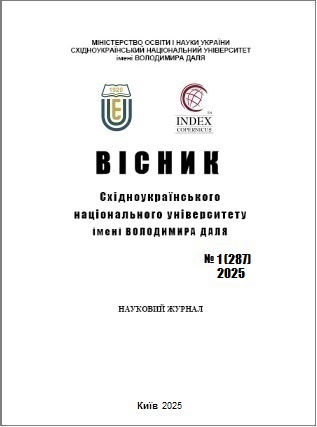Application of computer design systems (CAD) in the development of innovative printing equipment: synthesis of functionality and design
DOI:
https://doi.org/10.33216/1998-7927-2025-287-1-30-38Keywords:
computer-aided design systems, printing equipment, digital modelling, innovative printing technologies, industrial design, design optimisationAbstract
The article presents a comprehensive study and development of scientific and practical approaches to the integration of computer-aided design (CAD) systems into the processes of creating innovative types and series of printing equipment, considering the synthesis of functionality and aesthetic design, which contributes to the improvement of the constructive and aesthetic parameters of printing systems. It was found that modern concepts of industrial design, which underlie the design of printing equipment, provide for a detailed analysis of human-machine interaction aimed at optimising the form, functionality and visual design of devices. The role of CAD as a key tool that not only improves the technological characteristics of printing systems, but also significantly reduces development time due to the capabilities of digital modelling and optimisation of structures, is studied. The advantages of using digital technologies that replace traditional drawing and modelling methods, simplifying the creation of technical documentation and making changes to constructive parameters, are assessed. It is substantiated that the automated generation of three-dimensional visualisations in CAD provides the design of the structure of printing systems considering materials, mechanical properties and ergonomic characteristics, allowing to simulate real operating conditions and conduct preliminary tests without the need to create physical prototypes. Approaches to the integration of CAD into specialised areas, such as computer-aided industrial design (CAID), conceptual design (CACD) and process design (CAPP), have been developed, which contribute to the optimisation of modelling and the identification of design flaws at an early stage. Ways to modernise existing CAD systems have been proposed to increase their flexibility in the development of innovative designs, taking into account the needs of the printing industry. It has been found that, despite a significant reduction in time and financial costs due to CAD, technological barriers remain associated with the lack of adaptability of software to the creation of complex mechanical systems, which requires further research.
References
1. Македон В. В., Холод О. Г., Ярмоленко Л. І. Модель оцінки конкурентоспроможності високотехнологічних підприємств на засадах формування ключових компетенцій. Академічнийогляд. 2023. № 2 (59). C. 75-89. DOI: 10.32342/2074-5354-2023-2-59-5.
2. Ajao K.R., Ibitoye S.E., Adesiji A.D., Akinlabi E.T. Design and Construction of a Low-Cost-High-Accessibility 3D Printing Machine for Producing Plastic Components. Journal of Composites Science. 2022. no 6(9). 265. https://doi.org/10.3390/jcs6090265
3. Akhilesh, Musavvir M., Sameer M., Shashikanth G. Design and Development of 3D Printing Machine. International Journal of Scientific Research and Engineering Development. 2020. №3(3). pp. 1–8. https://ijsred.com/volume3/issue3/IJSRED-V3I3P1.pdf
4. Budinoff H.D., Kramer J. CAD as a Virtual Prototyping Method: Uses and Timing of Computer-Aided Design Artifacts in Hardware Design. International Journal of Engineering Education. 2022. Vol. 38. No. 6. pp. 1747–1760.
5. The Different Types of Printing Press: Exploring Variety in Print Technology. URL: https://www.ketegroup.com/exploring-the-different-types-of-printing-press/
6. Gilmanova A.M. Computer-aided design systems for product life cycle stages. Journal of Physics: Conference Series. 2020. №1661(1). pp. 012205. https://doi.org/10.1088/1742-6596/1661/1/012205
7. Hunde B.R., Woldeyohannes A.D. Future prospects of computer-aided design (CAD) – A review from the perspective of artificial intelligence (AI), extended reality, and 3D printing. Results in Engineering. 2022. №14. pp. 100478. https://doi.org/10.1016/j.rineng.2022.100478
8. Ji Y.-J., Guo Y.-J., Gao F.-Q., You X.-P., Liu Z.-H., Zheng Q.-M. Design of pattern drawing software for 3D food printing equipment. In: Xia J. (Ed.), Proceedings of the Second International Symposium on Computer Technology and Information Science (ISCTIS 2022), SPIE. 2022. Vol. 12474. 124740D. https://doi.org/10.1117/12.2654061
9. Li N., Liu C. Computer-Aided Industrial Design in the Context of Intelligent Manufacturing. Computer-Aided Design & Applications. 2025. Vol. 22(S9). pp. 14–26. https://doi.org/10.14733/cadaps.2025.S9.14-26
10. Makedon V., Myachin V., Plakhotnik O., Fisunenko N., Mykhailenko O. Construction of a model for evaluating the efficiency of technology transfer process based on a fuzzy logic approach. Eastern-European Journal of Enterprise Technologies. 2024. no 2(13(128)). p. 47-57. https://doi.org/10.15587/1729-4061.2024.300796.
11. Metelenko N. G., Kovalenko O. V., Makedon V., Merzhynskyi Y. K., Rudych A. I. Infrastructure Security of Formation and Development of Sectoral Corporate Clusters. Journal of Security and Sustainability Issues. 2019. №9(1). pp. 77–89. http://doi.org/10.9770/jssi.2019.9.1(7)
12. Mikolajczyk T., Malinowski T., Moldovan L., Hu F., Paczkowski T., Ciobanu I. CAD CAM System for Manufacturing Innovative Hybrid Design Using 3D Printing. Procedia Manufacturing. 2019. №32. pp. 22–28. https://doi.org/10.1016/j.promfg.2019.02.178
13. Pinterest. URL: https://www.pinterest.com/pin/3377768463203450/
14. Tan, Q., & Li, H. Application of Computer-Aided Design in Product Innovation and Development-Taking in Industrial Design Process. IEEE Access. 2024. https://doi.org/10.1109/ACCESS.2024.3404963
15. Wang R., Fang T., Zhou X. Computer-Aided Cultural and Creative Product Design Based on Reinforcement Learning. Computer-Aided Design and Applications. 2025. Vol. 22(S7). pp. 55-67. https://doi.org/10.14733/cadaps.2025.S7.55-67
16. Wang J., Xu P. Innovative Application of CAD Technology in Animation Design and Its Integration with Visual Teaching. Computer-Aided Design and Applications. 2024. Vol. 21(S27). pp. 229–244. https://doi.org/10.14733/cadaps.2024.S27.229-244

